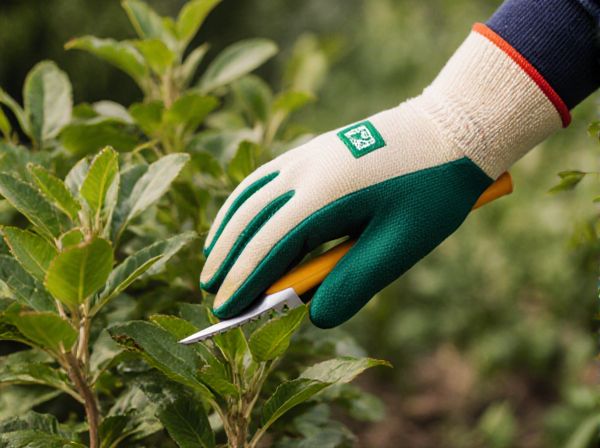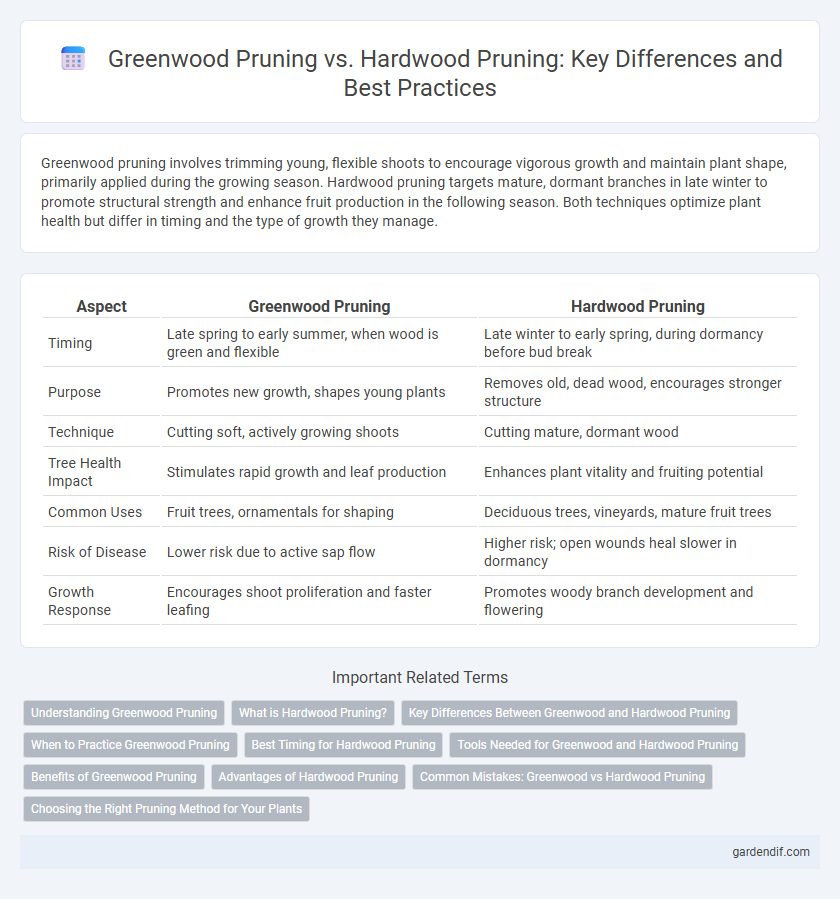
Greenwood pruning vs hardwood pruning Illustration
Greenwood pruning involves trimming young, flexible shoots to encourage vigorous growth and maintain plant shape, primarily applied during the growing season. Hardwood pruning targets mature, dormant branches in late winter to promote structural strength and enhance fruit production in the following season. Both techniques optimize plant health but differ in timing and the type of growth they manage.
Table of Comparison
| Aspect | Greenwood Pruning | Hardwood Pruning |
|---|---|---|
| Timing | Late spring to early summer, when wood is green and flexible | Late winter to early spring, during dormancy before bud break |
| Purpose | Promotes new growth, shapes young plants | Removes old, dead wood, encourages stronger structure |
| Technique | Cutting soft, actively growing shoots | Cutting mature, dormant wood |
| Tree Health Impact | Stimulates rapid growth and leaf production | Enhances plant vitality and fruiting potential |
| Common Uses | Fruit trees, ornamentals for shaping | Deciduous trees, vineyards, mature fruit trees |
| Risk of Disease | Lower risk due to active sap flow | Higher risk; open wounds heal slower in dormancy |
| Growth Response | Encourages shoot proliferation and faster leafing | Promotes woody branch development and flowering |
Understanding Greenwood Pruning
Greenwood pruning refers to the selective trimming of young, vigorous shoots during the growing season to promote healthy growth and improve air circulation within the canopy. Unlike hardwood pruning, which involves cutting back older, dormant wood during the winter, greenwood pruning targets live, soft tissue to shape the plant and control size without the risk of severe damage. This technique is essential for species like fruit trees, where timing and precision directly influence future yields and overall plant vitality.
What is Hardwood Pruning?
Hardwood pruning involves cutting back deciduous trees and shrubs during their dormant season to promote vigorous growth and improve structure. Unlike greenwood pruning, which targets soft, new shoots, hardwood pruning removes older, woody stems to enhance light penetration and air circulation. This technique is essential for plants like roses and fruit trees to maximize flowering and fruit production.
Key Differences Between Greenwood and Hardwood Pruning
Greenwood pruning targets young, flexible branches of recently grown trees to encourage healthy shape and structure, while hardwood pruning involves cutting back mature, dormant wood during late winter to promote vigorous spring growth. Greenwood pruning is typically performed multiple times per growing season to manage rapid growth, whereas hardwood pruning is done once or twice annually to rejuvenate older trees. The choice between the two methods depends on tree species, growth stage, and desired horticultural outcomes.
When to Practice Greenwood Pruning
Greenwood pruning is most effective during late spring to early summer when the branches are still flexible and the plant is actively growing, promoting quicker healing and less stress on the tree. Hardwood pruning, in contrast, is typically reserved for late winter or early spring when the tree is dormant, reducing the risk of disease. Practicing greenwood pruning at the optimal growth stage ensures improved shape control and encourages vigorous new growth in species like fruit trees and flowering shrubs.
Best Timing for Hardwood Pruning
Hardwood pruning is best performed during the dormant season, typically late winter to early spring, before new growth begins, to minimize stress and prevent disease. Pruning hardwood trees at this time encourages vigorous spring growth and allows wounds to heal quickly in warmer weather. Unlike Greenwood pruning, which occurs in early summer when trees are actively growing, hardwood pruning during dormancy promotes structural integrity and long-term health.
Tools Needed for Greenwood and Hardwood Pruning
Greenwood pruning requires sharp bypass pruners, long-handled loppers, and a sturdy pruning saw designed for cutting living, flexible branches with higher moisture content. Hardwood pruning demands more robust tools such as heavy-duty pruning shears, bow saws, and pole pruners to efficiently cut through denser, drier, and tougher branches typical of dormant wood. Proper maintenance and sharpening of these tools ensure clean cuts that promote healthy regrowth and reduce the risk of disease for both greenwood and hardwood pruning tasks.
Benefits of Greenwood Pruning
Greenwood pruning promotes faster wound healing and reduces the risk of disease by cutting during the tree's active growth phase. This method preserves the tree's natural sap flow, enhancing nutrient distribution and overall vitality. Compared to hardwood pruning, greenwood pruning results in less stress and supports sustained healthy growth.
Advantages of Hardwood Pruning
Hardwood pruning promotes stronger branch structure and enhances fruit production by stimulating the growth of fruitful spurs on mature trees. This method reduces the risk of disease spread and pest infestation by removing old, non-productive wood and improving air circulation within the canopy. Compared to greenwood pruning, hardwood pruning requires less frequent maintenance and supports long-term tree health and productivity.
Common Mistakes: Greenwood vs Hardwood Pruning
Common mistakes in Greenwood pruning include cutting too early before the wood has fully hardened, which can lead to increased sap flow and vulnerability to pests. In contrast, Hardwood pruning errors often involve improper timing during dormancy, causing delayed healing and higher risk of disease. Understanding the distinct growth cycles and tissue maturity between Greenwood and Hardwood is crucial for effective pruning and promoting tree health.
Choosing the Right Pruning Method for Your Plants
Greenwood pruning targets young, flexible shoots, promoting vigorous growth and shaping plants early in the growing season, ideal for shrubs and fruit trees requiring fast development. Hardwood pruning involves cutting older, dormant branches during late winter, encouraging stronger structural growth and fruit production in mature hardwood trees. Selecting the appropriate pruning technique depends on plant species, growth stage, and desired outcomes like increased yield or enhanced shape.
Greenwood pruning vs hardwood pruning Infographic

 gardendif.com
gardendif.com